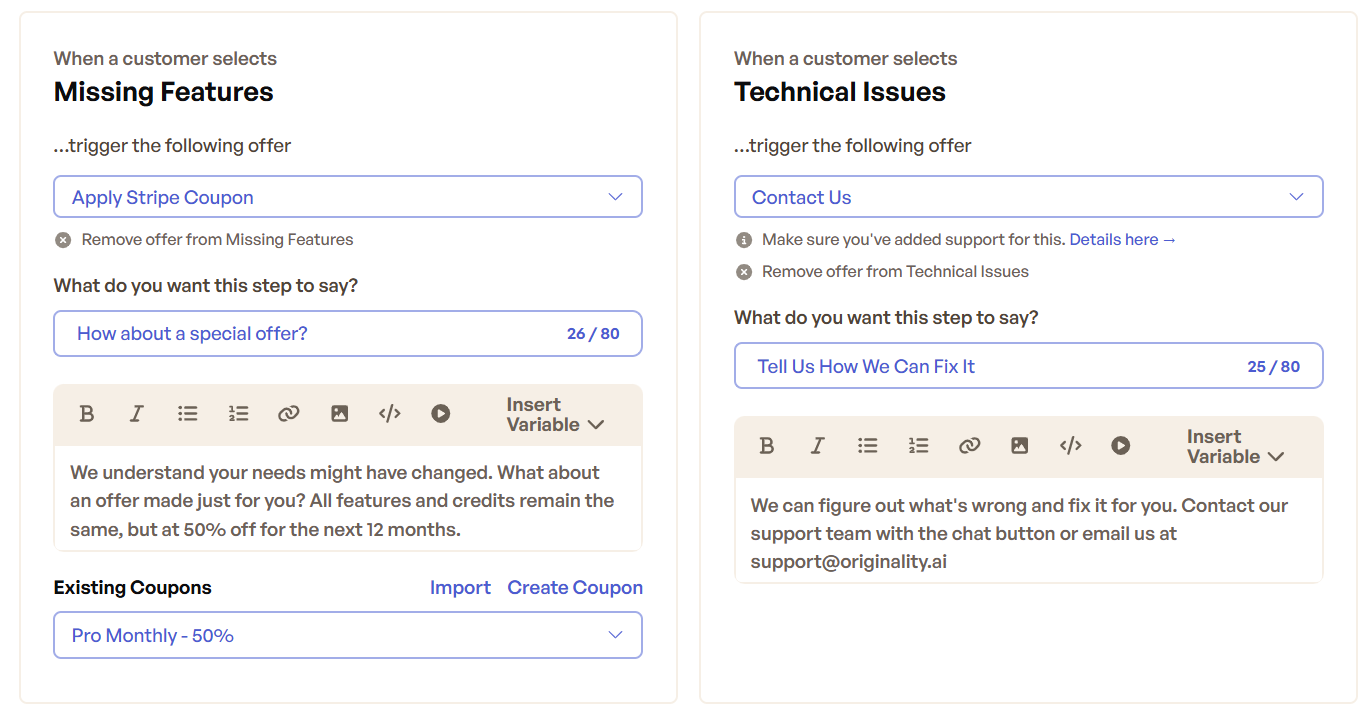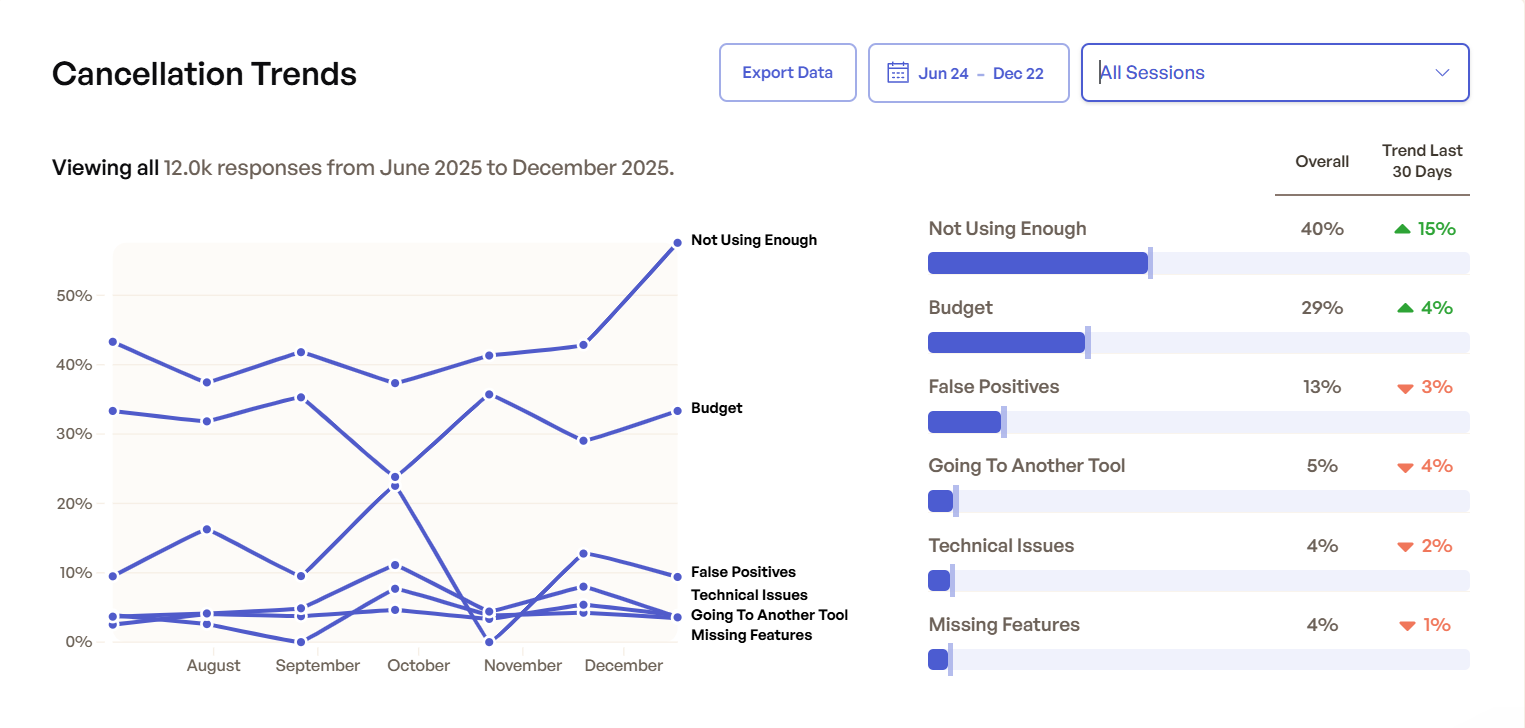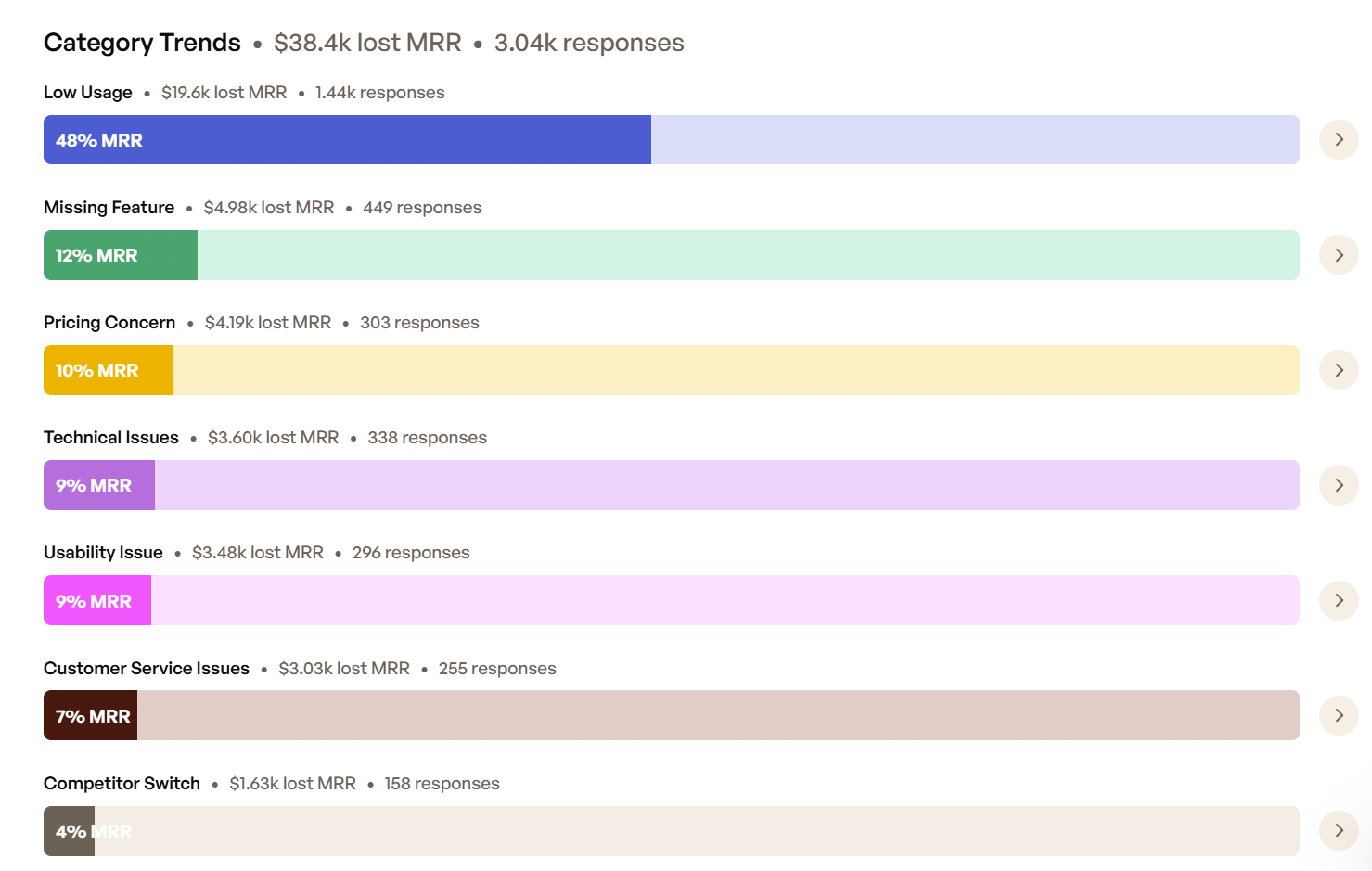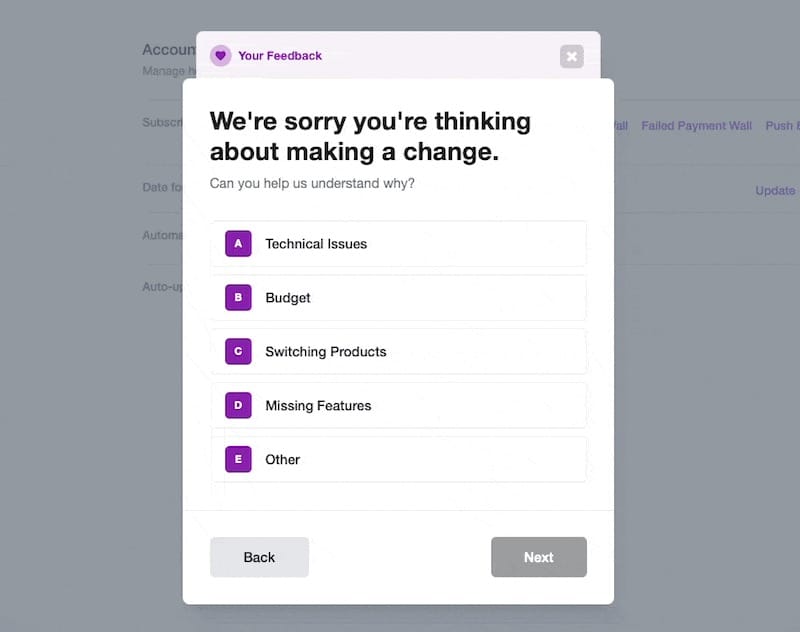How to Perform Churn Analysis: From Measurement to Prevention

For any SaaS company, understanding what churn is and how to analyze it is a core pillar for building a successful subscription business. Even a small reduction in customer churn can dramatically increase your profits. That’s why regular churn analysis is critical to the long-term health of your SaaS business.
Key Takeaways:
- Regular churn analysis helps you identify the real reasons customers leave, rather than relying on assumptions or isolated data.
- Combining quantitative and qualitative insights gives you a complete picture of churn patterns, customer behavior, and where your product experience has issues.
- A structured churn analysis process allows you to connect churn to financial impact, prioritize fixes, and design targeted retention strategies.
- Turning churn insights into real action is essential for long-term SaaS growth and profitability.
What is Customer Churn Analysis?
Customer churn analysis is the evaluation of your customer churn rates with the goal of reducing overall customer loss. By analyzing churn rates and other key indicators of churn, you can gain valuable insights into the problems that cause customers to leave. That knowledge can then be used to develop effective strategies to fight and reduce customer churn.
When Should You Perform Churn Analysis?
A good practice is to perform churn analysis regularly, even when nothing seems wrong, because some patterns develop gradually.
You should also run an analysis whenever you implement a change that could negatively affect your churn rates, or when an unexpected event is observed. For example, this could include a sudden spike in churn or a rising churn trend over the past few months.
Tools to Use for Measuring Churn
Before you start the analysis, you need several tools to check different parts of the customer journey:
- Subscription management platforms such as Stripe Billing, Chargebee, Recurly, or Paddle.
- Your CRM and support systems, like Salesforce or HubSpot for pipeline data, and Zendesk or Intercom for tickets and conversations.
- A churn analytics and retention platform, like Churnkey, that lets you run in-product surveys, collect structured “reasons for leaving,” test tailored discounts, pauses, or downgrades, and retain more subscribers. It also recovers failed payments, letting you measure exactly how much churn you’ve prevented and how much MRR you’ve regained.

Combine Different Churn Analysis Methods
The churn analysis method you choose should align with your business model and data volume. For example, B2B SaaS companies with smaller but high-value accounts often benefit from very granular, account-level insights, while B2C companies with large user bases should lean more on pattern detection at scale.
Quantitative Analysis
Quantitative analysis uses numbers to track patterns in signups, product usage, billing events, and cancellations over time, allowing you to separate noise from structural problems. It is often done in two ways:
- Cohort analysis - grouping customers by a shared characteristic (for example, signup month, acquisition channel, or plan) and then monitoring how each group behaves over time.
- RFM analysis - grouping the customers into different groups based on how recently they engaged, how often they engage, and how much revenue they generate.
Qualitative Methods
Qualitative methods help you analyze the context, psychology, and expectations behind the actions that numbers alone can’t show. When you systematically collect and analyze qualitative data alongside your quantitative data, you get a more detailed, fuller picture of the causes of churn. Qualitative data is gathered in the following ways:
- User interviews - By speaking directly with recently churned users, you understand misaligned expectations, missing features, high prices, or friction points.
- Images - Annotated screenshots, user-submitted error photos, or recordings of confusing workflows can reveal issues that customers struggle to describe verbally.
- Usability testing - Monitor how customers interact with your product in real time and capture the exact moment when the churn risk is triggered.
Customer Churn Analysis Process Step by Step
The churn analysis process includes a raw data export, cleanup, and data grouping by factors such as pricing, lifecycle stage, acquisition channel, etc. You separate the patterns, test what you found, and develop fixes. However, the process doesn’t end there; churn analysis is an ongoing part of your customer retention strategy.
Measure and Audit Your Churn Numbers
Start by calculating your core churn metrics. Be consistent and use the same formulas and time periods to avoid distorting the data. To get the full picture, calculate both customer churn and revenue churn, as they highlight different issues in your business. Document the process so you can track changes and ensure your team is aligned on how churn is being calculated and interpreted over time.
Collect and Organize Available Data
Pull raw data from your billing system, product analytics, CRM, and support tools so you can check both subscription history and customer behavior. Clean and standardize the data across all sources, remove duplicates, and fix errors. Remember to exclude test accounts. After that, group customers by pricing plan, lifecycle stage, acquisition channel, company size, geography, etc. At this stage, your goal is to create a clean, structured dataset that makes it easy to spot patterns in churn.
Data on Customer Engagement, Usage, and Requests for Support
Telltale signs of customer churn include a decreasing usage rate. Monitoring how long your customers have used your service before their usage starts to decline helps you identify at-risk customers earlier.
The frequency of support tickets is another signal of customer satisfaction. An increasing number of support tickets may indicate that the product is too hard to use or has many issues (bugs, crashes, etc.). On the contrary, receiving fewer tickets than normal may be a result of declining user engagement with your product.
Data on Pricing and Competitor Pricing Models
Collect data on your own pricing plans and on your competitors’ pricing models. What kinds of deals, discounts, and pricing packages are you offering, and how do they compare to others in your market? Are your pricing structures aligned with what customers expect in your industry? Collecting this data helps to understand how pricing influences customer decisions, so you can see when churn is driven by price rather than by product or user experience.
Customer Behavior, Preferences, and Drop-off Points

In the above offboarding flow, customers can either keep using what you offer or leave. But even within these two categories, you can identify many different patterns that you can use to reduce churn.
Through churn analysis, you can sort and filter customer types based on behavioral similarities. For example, customer types that:
- Use certain features most or least,
- Engagement rates are likely to decrease after a specific time frame,
- They are associated with specific churn types.
You can use Churnkey’s session recordings for a better analysis of customer drop-off points.
Customer Segmentation
Customer segmentation groups users with similar traits so you can analyze churn patterns within each group. Collecting segmented data allows you to see whether churn risk varies by how long customers have been using your product and how different incentives, such as discounts, coupons, or special offers, affect churn within each segment.
Collect Data on Voluntary and Involuntary Churn
If you treat voluntary and involuntary churn as one, you’ll chase the wrong problems and “fix” things that weren’t broken. Voluntary churn occurs when customers intentionally cancel due to product gaps, pricing concerns, poor onboarding, or a perceived lack of value. Involuntary churn is entirely unintentional, often caused by expired cards, insufficient funds, or billing errors, and requires a different solution.
Pair your cancel reasons, survey responses, and support conversations with payment failure codes and recovery rates from your billing stack. That combination tells you whether you should be improving the product, rethinking pricing, or just getting smarter about dunning and payment retries.
Economic Impact Analysis
An economic impact analysis shows how churn affects your revenue, profit, and long-term growth, rather than treating churn as just another metric. You must connect churn analysis to key financial metrics such as MRR/ARR lost, customer acquisition cost (CAC), customer lifetime value (check our LTV calculator), and gross margin (use our free gross margin calculator) to understand the true cost of losing each customer.
Besides estimating the immediate revenue loss when customers cancel, you should also calculate the future revenue they would have generated if they had stayed, plus the additional acquisition spend required to replace them.
Create a Churn Prevention Plan Based on Analysis
Now that you know why your customers are leaving, you can design processes to prevent churn and reduce it over time. Here are some of the most commonly used practices:
- Ensure that you have a proper offboarding process. In the image below, you can see how Churnkey presents customers with more value each time they click the cancel button.

- Monitor cancellation insights and how effective your offboarding incentives are.


- Collect regular feedback from customers. Apart from collecting SaaS user cancellation insights, it is a good practice to send out simple outreach emails with a personal touch from the CEO.
"Listening to our clients is the most important thing we do. We look at every piece of feedback we collect and distribute the most actionable, insightful bits to relevant internal teams. We needed a better way to categorize, parse, and score feedback automatically."
Charley Burtwistle, Senior Director of Core Subscription at Buildertrend
- Acknowledge customer feedback and implement changes. Use emails and social media channels to let them know that a better version of the product will be released.
- Depending on your churn analysis, you should redirect customers who are attempting to cancel to a more appropriate pricing tier.
- Create effective, data-informed cancellation flows. Use your churn analysis insights to design a streamlined cancel experience that addresses common objections and gives at-risk customers reasons to stay.

Churnkey’s cancel flow in action
- By analyzing historical churn data, customer behavioral patterns, lifecycle trends, payment failures, etc., you can build predictive churn models that estimate which customers are most likely to churn and when.
Challenges of Churn Analysis
It’s easier said than done, and churn analysis comes with challenges you need to be aware of, such as:
- The difficulty of accurately calculating churn across specific business models.
- Ensuring accurate and complete data collection and maintaining high data quality.
- Centralizing data from billing systems, product analytics, CRM, support tools, etc.
- Scarce time and resources.
- Turning churn insights into an actionable plan for its prevention.
Why Should You Focus on Churn Analysis?
Here are some other benefits that come with analyzing your churn:
- Churn analysis helps you identify customer behavior at every touchpoint within your product.
- It prevents you from making random assumptions about customer retention issues.
- Analyzing customer churn gives you a clearer idea of what leads to churn and what you should change.
- Through churn analysis, you can uncover trends and motivators behind why customers are leaving.
- With historical customer data, your company can predict churn and adopt proactive approaches (e.g., allowing customers to pause subscriptions) to improve retention.
Conclusion
Churn analysis isn’t a one-time project you check off and forget. When you consistently measure what’s happening, understand why it’s happening, and act on those insights, churn becomes controllable. Most teams don’t lack data; they lack a clear process, a single source of truth, and the tools to turn churn insights into meaningful retention wins.
If you want to put this entire approach on rails (cancellation insights, personalized offers, and smart retries) Churnkey can help you do it without rebuilding anything yourself. Try our demo and see how high-performing SaaS teams reduce churn and recover revenue automatically.



